Digital Dental Advertising VS Dental SEO
Which one produces better ROI?
For a dental practice to be successful, it needs to engage in a robust digital dental marketing plan. Relying on word of mouth and hoping to be the only dentist in town will only work in very rural parts of the country.
Chances are you not only have other dental competitors, but they are also engaging in digital advertising. Digital dental advertising specifically means “placing ads for your dental services on digital mediums”, however, many dentists and dental practice managers, use this term loosely, what they mean is “How do I get more dental patients” . So we will use this definition.
According to ADA (American Dental Association) Annual income of $204K for general dentists and $343K for specialists, However this can be much higher if you employ dental marketing and advertising techniques. If you plan to grow your dental practice, digital dental advertising can not be ignored.
The actual advertising budget for each dental practice is different. Some dentists are very aggressive and spend $1000 per day (or more) and some spend $1000 a month on advertising. We also have few dental practices who do not spend any money on online advertising, they doctors rely on referrals and very strong SEO rankings. This data refers to online advertising, not offline advertising spend.
When a dentistry is marketing their practice, their website will be a significant part of that medical marketing plan. A dental practice will want to promote that website to attract more patients. While there are many ways to promote a website, Dental SEO and Dental PPC Advertising are often considered the two main ways to promote a website. A dentist needs to stand out from their competitors and establish a brand. If they can build patient loyalty, they can grow and keep an edge over their competitors. While in the past, word of mouth and referrals from friends and family were enough to keep a dentist in business, they must use Dental SEO and Dental PPC Advertising to promote a well-designed website so that they appear as often as possible to a potential patient.
Dental SEO and Dental PPC Advertising should be handled by a marketing professional and not a random staff member inside a dental practice. While many systems are easy to use and the concepts of good dental SEO are not overly complicated, it does take a significant amount of time to manage both properly. Both Dental SEO and Dental PPC advertising need to be monitored on a regular basis. While neither should be changed daily, as that would likely disrupt a campaign, they need to be watched for any issues. A dental practice does not want to find out four to eight weeks later that SEO keywords are not performing and that their PPC budget has been set so low that they are running out of money for ads before lunch. A professional dental, medical marketing expert will know what to look for, what metrics to follow, and when to alert an owner or manager that changes are needed. The experts at PatientGain.com have years of experience in Dental SEO and Dental PPC Advertising and can bring those skills to help a dental practice succeed!
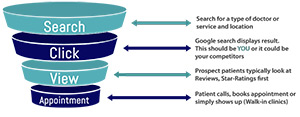
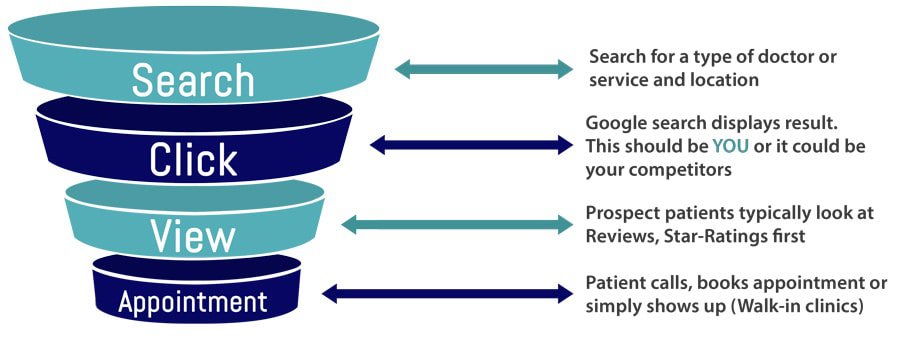
Dental practices – General dentists
The typical range is $750 to 2800 per month, spend on average spend $1830 per month per location.
Dental practices – General dentists with cosmetic focus (implants, Invisalign)
These dental practices treat general dentistry patients, like cleaning, and yearly preventive exams, however their focus is big ticket items. This typically includes dental implants, Invisalign, and other similar services. The typical range is $2550 to 5800 per month, spend on average spend $3800 per month per location.
Dental practices – Specialist dentists
The typical range is $1300 to 3210 per month, spend on average spend $2240 per month per location. These type of practices include Endodontists, TMJ disorders, sleep apnea, oral appliances etc.
Dental practices – Celebrity & cosmetic focus
The typical range is $8300 to $18850 per month, spend on average spend $9600 per month per location. These type of practices include dentists who do not accept insurance, and accept limited amount of patients, but each patient is treated as a “celebrity” with extreme focus on customer service, and results for each patient. Services include invisalign, porcelain veneers, whitening, bonding, laminates, implants, and orthodontics.
Table of contents:
- What is dental SEO?
- What is dental PPC advertising?
- A dental practice will rely on search engine optimization (SEO) for long-term exposure and success.
- PPC (Pay-per-click) advertising provides a dental practice with immediate visibility in search results.
- Should a dental practice go with Dental SEO or Dental PPC Advertising? Which one provides the better ROI?
- Content Marketing
- Example of promotional content marketing.
- Social Media Marketing
- Example of social media content post. Before and after image of a patient treatment. Dental practice located in Dallas DFW area of Texas.
- Case Study: Pay Per Click Advertising on Google
- Dental Practice Engagement Chatbot
- Text Message Review Requests
- Facebook advertising case study
- Case study dental advertising: Google ads vs Facebook ads
1. What is dental SEO?
Short for Search Engine Optimization, SEO is crucial to your website being correctly presented as a relevant result by search engines to its users. The goal of Google, Bing, and all other search engines is to provide their users with the most relevant results when users use keywords to search. If a search engine returns results that are not helpful to a user, then they are less likely to use that search engine in the future, hurting the overall business. So, the easier you make it for a search engine to understand your website, the more likely you are to reach your target audience!
Dental SEO, or Dental Search Engine Optimization, is the process of helping search engines better understand the context of a site so it can display it in search results. Good Dental SEO will have a dental practice’s website appear in the top search results for keywords their target audience is most likely to use when searching for care. While a search engine will return millions of pages of reviews, almost no one will look past the first page of results. Many will only look at the first two or three top organic results. Dental practices need to appear in those top results for their target keywords with that in mind.
As previously mentioned, the keywords selected to be target SEO keywords should be the keywords current, and potential patients would use when looking for dental care. Additionally, medical and technical terms also need to be included to raise the quality, relevance, and authoritativeness of a site in the eyes of a search engine. Words need to be sprinkled throughout the website but be relevant to the page. Avoid stuffing as many keywords into paragraphs as possible. This is frowned on by search engines and will result in penalties in organic rankings. SEO work takes time to produce results, so do not try any tactics to speed it up artificially.
Both short-tail keywords and long-tail keywords need to be selected for SEO work. Both keywords work together to help boost the organic rankings of a dental practice. Short-tail keywords are three words or less, drive higher traffic to a site, cover broad topics, are competitive, and have lower conversion rates. Long-tail keywords are four words or more, do not drive as much traffic to a site, focus on unique or specific topics, are not as competitive, and have high conversion rates. Long-tail keywords play a more significant role in the expanding world of voice search. When people use voice search on a smart speaker or a personal digital assistant, they generally ask questions that are four words and longer. If a dental practice can have similar or exact questions and answers on their site, they will they have a competitive advantage in voice search.
First, you need to develop a list of keywords and phrases for your website. These keywords and phrases need to be the words your target audience most likely uses when looking for dental services. It is unlikely new patients are going to know the name of your practice. While you probably will rank very well for your name, it is not a keyword many new patients will use. A list of words and phrases patients use while looking for services needs to be developed. It is essential to include the medical names for teeth, symptoms, treatments, and other everyday names. Most of your patients are not going to be familiar with the technical terms used by dentists. Including everyday terms and phrases for things will help get your website listed in organic results. With that said, do not entirely ignore medical terms. Adding them also adds to a website’s domain authority.
When placing SEO Keywords in the content of your dental practice’s website, do not pack in as many as possible. Search engines disapprove of this practice, and your organic rankings are likely to suffer. Sprinkle them on your content pages and on pages where they are the most relevant. While it often takes up to 6 months for you to see results from this work, it is a very cost-effective way in the long term to promote your dental practice. Learn more about dental SEO and healthcare SEO.
Example of dental SEO – A potential dental patient searching for a “family dentist”. Patient located in Toledo OH.
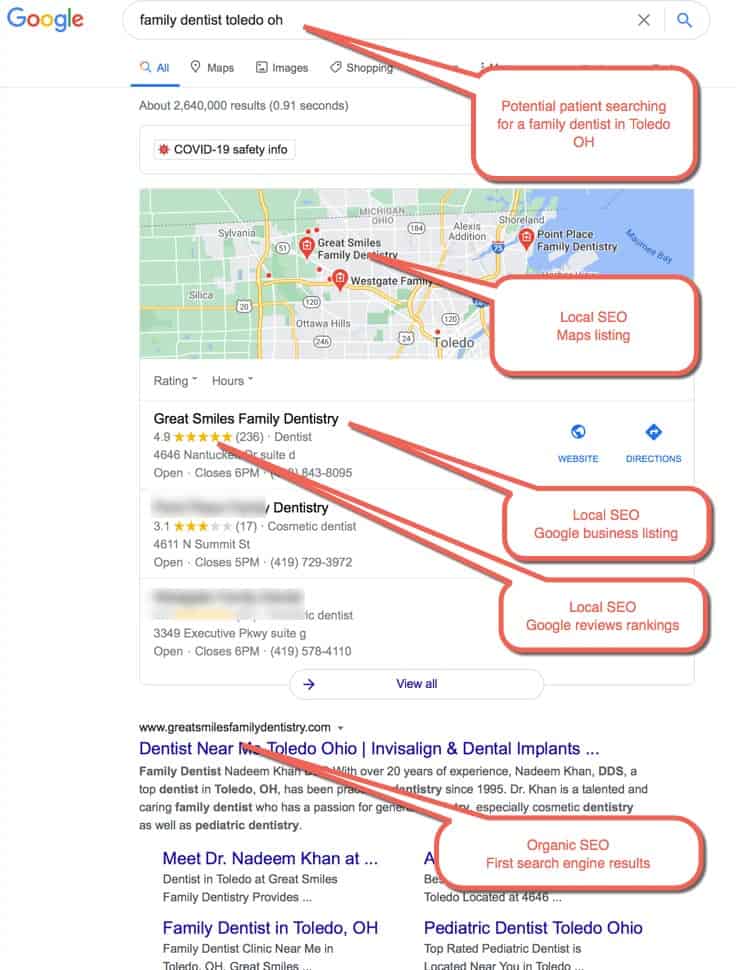
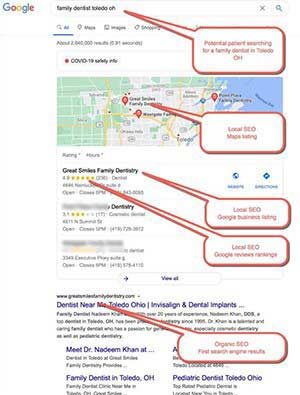
2. What is dental PPC advertising?
PPC ads are the first thing people see when searching online for anything. Search engines, such as Google and Bing, will often present several “paid results” first before showing the organic results. Determining which businesses get their ad shown in paid results depends on how relevant it is to the search and a bidding process. If the ad is relevant to the search and a high enough bid is made, it will appear in the paid results. A dental practice will only pay if their ad is clicked on, hence the term pay-per-click, or PPC. This differs from display advertising, where a business will pay an amount depending on the number of times (known as impressions) an ad is displayed on a website. Display ads tend to appear on other websites, like blogs. PPC advertising is generally seen as the more effective of the two kinds of advertising for dental practices.
When creating a dental PPC campaign, a dental practice will choose words it wants to “bid’ on to appear in the paid results. The words a dental practice chooses will often be the exact SEO keywords to sprinkle throughout their site. When building organic ranking, they will want to appear to their target audience in these results. When dental practices already have good organic rankings, they will still want to appear in paid results, although they may reduce their budget. A strong marketing message can be made when a patient sees a dental practice in paid and organic results. The more times a dental practice appears, be it in search results, social media profiles, or email marketing messages, the more likely that brand will be engrained in a patient’s mind, promoting a patient’s brand loyalty towards a practice.
PPC Advertising efforts also work best when they are organized into campaigns. Instead of having all ads for a dental practice in one campaign named “Dental PPC Ads,” they often work better if grouped into similar campaigns. For example, a dental practice could have:
- Brand Campaign – A general campaign is pushing the practice’s name to build community awareness.
- Services Campaign – A campaign that focuses on a specific dental service being offered. There may be several campaigns, each focusing on a service to promote.
- Competitor Campaign – A campaign that targets competitors so that an ad will appear on search results for keywords that are important to nearby competitors.
Google will likely be the leading search engine where PPC advertising takes place. According to recent studies, Google has at least 85% of the search engine market. Bing usually has nearly 7%, and Yahoo has about 3%. Combined, that is 95% of all searches. Many dental practices only advertise on Google, which is the dominant search engine. However, some dental practices have seen success, good conversion rates, and high ROIs when advertising also on Bing and Yahoo in addition to Google. If there is bandwidth for a PPC manager to manage more than one PPC campaign on a search engine, it may be worth exploring for a dental practice.
3. A dental practice will rely on search engine optimization (SEO) for long-term exposure and success.
Given enough time, good SEO work will help boost the organic rankings of a dental website. If target keywords can achieve and maintain good rankings, it will increase traffic to the website from people within a target audience looking for a dental practice. The organic rankings of search engines are free. A competitor can not buy their way to the top, although they can spend that money to improve SEO and content to be more relevant in search results.
SEO work takes time to push websites to the top of target keyword search results. High organic rankings do not happen overnight, and there is no ethical or legal way to make that rise happen faster. Search engines are constantly looking at websites across the entire internet, and it takes time for them to circle back, look at a site, and figure out how it ranks within their search results. However, once a website gets that high ranking, they generally can maintain it as long as they aggressively maintain their SEO. This means constantly tweaking their target keywords, updating content, and ensuring they have the right keywords on their content pages. Keywords change over time, so staying up to date is a good idea.
While SEO work does take time and effort, it can provide long-term benefits to a dental practice. Given proper maintenance, it can secure a dental practice’s top search spot in a community. While heavy on the front end in terms of putting time and money into good SEO work, the long-term benefits make quite effective use of advertising money and provide good ROI to a dental practice.
4. PPC (Pay-per-click) advertising provides a dental practice with immediate visibility in search results.
Paid search results are the first thing people using search engines see when looking for information online. It is quite uncommon to have search results with no paid results. Being the first thing people see can be a very powerful marketing touchpoint. Well-written paid ads will have a link and ad copy that matches people’s keywords to find a dental practice. For example, if someone is looking for a dentist for a root canal, the ad shown to them should talk about that service and have a compelling call to action. Failing to achieve that, the person searching will look at other ads, map results, and then organic results.
The most prominent advantage dental PPC advertising has over dental SEO is its immediate results. Once a PPC campaign is set up, assuming the correct relevant keywords are selected, and enough budget is allowed, a dental practice should see its ad begin to run within 24 hours. PPC advertising is helpful for dental practices when they want to promote specific services to specific places. For example, if a dental practice wanted to promote teeth whitening in one zip code but emphasized pediatric dental services in another zip code, that could quickly be done with PPC advertising. The immediate results and performance tracking make PPC advertising very effective and provide good ROI to a dental practice.
Pay-per-click ads, also known as PPC ads, are a great way to quickly get your dental website in front of your target audience. It is widely used when a dental practice has just opened or offered a new service on their website. When anything is newly pushed online, be it a new website or a page, it does not have a lot of SEO value. It will take time for it to start to show up in organic results. While waiting for that to happen, paid search ads can fill that gap to get that content in front of a target audience.
For paid search campaigns, you need to bid on keywords. When someone searches online and uses those keywords, you have a chance for your ad to appear, assuming you are bidding enough money for it. Your competitors are likely bidding on the exact words so that their ad will appear as well. There is often one to three paid ad spots, so your bids need to be enough to secure one of them. The budget for your ad campaign also needs to be big enough to last throughout the day. If you only have enough budget allotted for enough clicks for 2 to 3 hours, you should temper your expectations. You do not need to run ads 24 hours a day unless you run a 24-hour emergency dental practice. You also do not need to advertise every single hour your dental practice is open. Instead, aim to cover most hours of the day. If your budget usually runs out 2 or 3 hours before you close, that is generally good enough. Be mindful if you are closed for the weekends, other days of the week, or holidays. Save your budget for a day where you are open and do not run ads on those days where a practice is closed.
5. Should a dental practice go with Dental SEO or Dental PPC Advertising? Which one provides the better ROI?
Determining which marketing strategy, Dental SEO or Dental PPC Advertising provides better ROI is tricky. That depends on the period someone looks at. If Dental SEO and Dental PPC Advertising start simultaneously, Dental PPC Advertising provides better ROI in the short term. However, as time goes on, Dental SEO’s ROI will slowly but surely rise and soon be on par or provide a better ROI than PPC advertising. Dental PPC Advertising provides better ROI when focusing on specific services promoted by a dental practice. Dental SEO has better ROI when promoting the overall brand of a dental practice. As you can see, there are several variables to look at when determining which one provides a better ROI.
Implemented correctly, both SEO and PPC can get you on the front page of the search engines and in front of your intended audience. So, should your practice invest in an SEO strategy or a PPC campaign? The answer is both. These two medical marketing strategies work hand in hand very well for dental practices. Dentists can get the immediate results of a well-crafted PPC campaign and then enjoy the benefits of SEO on a long-term basis with great organic rankings. When used correctly, these tactics complement each other. They help patients looking for a general dentist find a practice’s website and those looking for specific dental services.
6. Content Marketing
Often working hand in hand with SEO work is content marketing. While it may be unsurprising to learn this, content plays a significant role in your organic rankings. The phrase “Content is King” is not just some clever saying that gets tossed around. The content of your dental practice needs to be several things:
- Informative
- Authoritative
- Useful
- Unique
- Engaging
For content to accomplish these goals, it needs to be a certain length. In many cases, dental practices should aim for at least 500 words, if not 1,000 words, for each page of their site. The amount of time an owner of a dental practice spends on a website is a factor in organic ranking. Two hundred words are going to be read faster than 1000 words. The more time someone spends on a dental practice’s website, the more authoritative they look. If someone clicks on a dental website and then quickly clicks back to search results, that indicates a less relevant website to the keywords being used.
Another aspect of content marketing is the constant updating of a dental practice’s website. An owner should always be adding, refining, or updating content pages of their site. This work should be done throughout the year and not all at once. Continuous content marketing work on your site will show search engines that your website is as up-to-date as possible. Content pages should be reviewed at least once a year to see if improvements need to be made. If you can not find anything meaningful to add or update to your website, consider starting a blog. Make it easy and commit to writing one post per month to update the blog. Content marketing, working with SEO, can significantly help the organic rankings of your dental practice’s website.
7. Example of promotional content marketing.
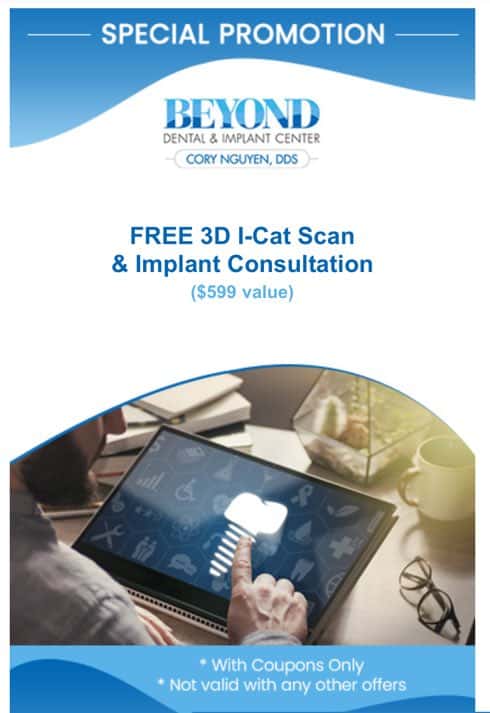
8. Social Media Marketing
Social media continues to play an essential role in a dental practice’s digital dental advertising efforts. It is a great way to keep in contact with current patients and reach others in the area. Social media channels have now become as common as having a business card. At this point, it is a little strange not to see some social media presence for a dental practice. While not all dental practices utilizing these social media platforms, the top ones you should consider creating a profile on include:
- Google Business Profile
Some dental practices also find it helpful to have profiles on:
- TikTok
- Snapchat
As for what to post on social media channels, do not make the mistake of assuming that every piece of content needs to promote your dental practice. If you are always trying to sell something to your patients, they will quickly tune out your posts, or worse, unsubscribe from your social media channel. While promoting your services is essential, it should be mixed with other health stories and local news. Ideally, posts should also include pictures of doctors, staff, and the facility with updates. Any sort of pictures or videos highlighting the dental practice and those who work there generally perform better than other posts.
Consider subscribing to a posting service that allows you to post to multiple accounts at the same time. This will save you time, so you do not have to log in and out of three or more social media accounts to post the same thing over and over again. These posting services do not allow you to access all of the bells and whistles of each social media channel, but they are very effective at posting an update with an optional picture, video, or link. This is usually sufficient for the majority of your posts.
Finally, social media channels have a robust advertising platform. While it does not have as extensive a reach as search engine advertising, also known as pay per click, it allows you to refine your targeting. Most social media channel will enable you to advertise to their users and narrow the target audience by:
- Location
- Age
- Gender
- Interests
- Keywords
All in all, the cost per click of social media ads is generally lower than pay-per-click ads. However, since most patients who click on your ads on social media, have more time than money, so overall quality of leads from social media is less than that of Google PPC ads (see next topic below). If targeting is used correctly, your ads can show a valuable target audience that is more likely to click on your ads. Social media channels each have their unique advertising platforms, so take time to look at what each one can provide you before putting your money into promoting a post. Ads on social media consistently outperform just boosting a post. We do not recommend spending money on boosting social media posts.
9. Example of social media content post. Before and after image of a patient treatment. Dental practice located in Dallas DFW area of Texas.
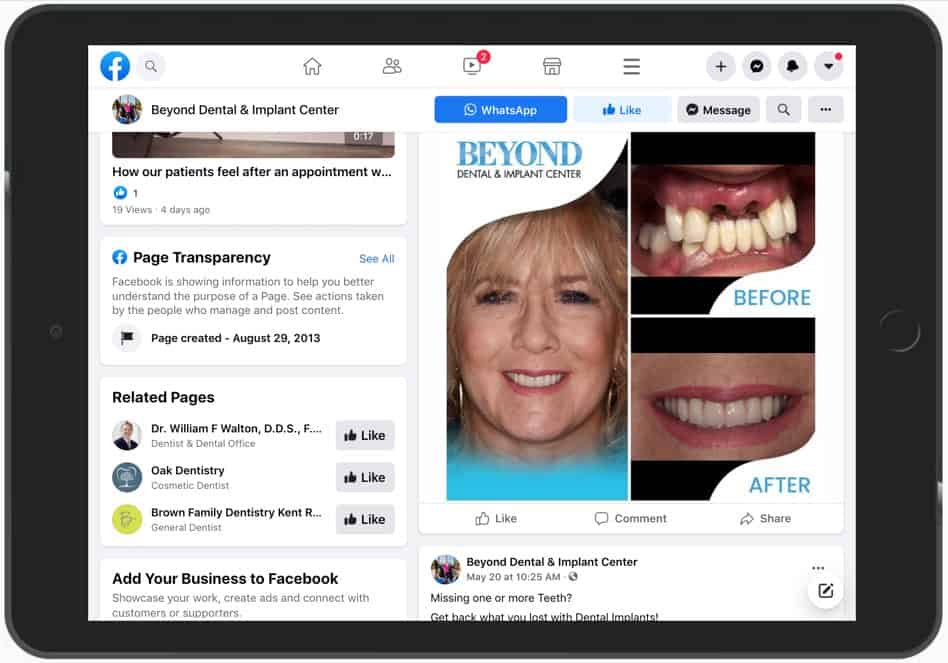
10. Case Study: Pay Per Click Advertising on Google
Example of PPC ads on Google. You will notice that “dental implant” has an extremely successful campaign. Overall the practice is flourishing with new patients every month.
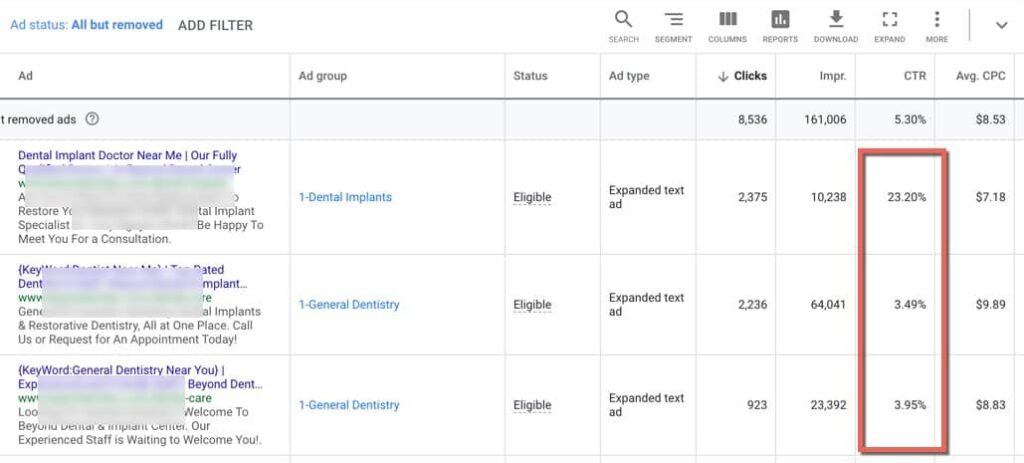
11 . Dental Practice Engagement Chatbot
Dental practice engagement chatbots are relatively new to dental practices but have been successfully used by the retail industry for years. The goal of a chatbot is to mimic human conversation with someone visiting your dental practice’s website. It is programmed to provide answers to a series of prewritten questions or help website visitors accomplish simple tasks. The benefit of using a dental practice engagement chatbot is that it should cut down on the number of phone calls and emails patients and potential patients make or send to your front desk. If programed with the most popular questions a front desk receives day in and day out, you should see an impact. This frees up the front desk staff to handle patients who need more attention for more challenging problems.
When developing a list of questions to program into a chatbot, many owners find it valuable to engage with the staff to who often answer them. Talking with them will give you an obvious idea of what questions they most likely have to answer throughout the day. For any questions a chatbot can not answer it will take the name and contact information from that website visitor and store it in a HIPAA secured dashboard so staff can review these questions and contact these patients. This is much better than going through a general email box, fishing questions out from general spam, or listening to voice mail messages trying to understand and write down the questions people ask.
Another great benefit of a dental practice engagement chatbot is that it is always on duty. It does not go home at night, go on vacation, or help others because of inclement weather. The most common things a chatbot does are direct people to web pages for specific information, help them make an appointment, or provide contact information and directions. Dental practice engagement chatbots can be updated at any time to address new medical issues, challenges, or situations that may cause patients to ask the same question many times.
However, all dental or medical ChatBots are not created equally. For example, it must be HIPAA compliant, by adding a dental or medical ChatBots your website should not become slow. We have seen this on many websites, which leads to longer page loads and hence, lower SEO rankings per Google’s pagespeed rankings algorithm.
Example of a dental practice chatbot. This app works 24×7 on your website (mobile, desktop, ipad) and converts potential patients to new paying patients and helps existing patients with common questions and answers.
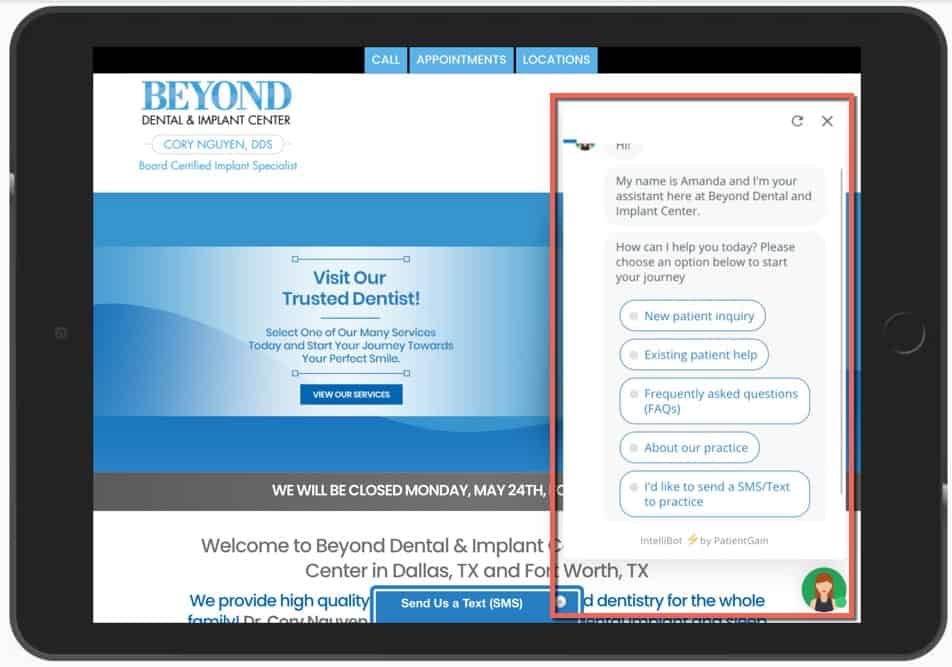
12. Text Message Review Requests
Reviews of your online listings are critical for the success of a dental practice. When a new patient discovers a dental practice, one of the first things they will look at is the reviews. If a dentist has too many negative reviews, that potential patient will look elsewhere. If a dentist has good reviews, but only a few reviews here and there, a rival dentist with more positive reviews stands a chance of getting that business. A dental practice will want a healthy listing with an increasing collection of positive reviews. There will undoubtedly be a few negative ones here and there, but the positive ones should vastly outweigh the negative ones.
The best way to get a review from a patient is to ask and make it as easy as possible to leave a review. Front desk staff asking patients to leave a review as they leave generally is not practical or effective. Sending an email for a review request can work, but there will be plenty of emails that end up in a spam or a promotional folder. Texting has proven to have a very high open rate and conversion rate compared to emails. Thank a patient for coming to your dental practice, and then provide them with a link to leave a review. Ideally, a single click should all it should take to leave a review. The fewer clicks a happy patient has to make, the more likely they will leave a review.
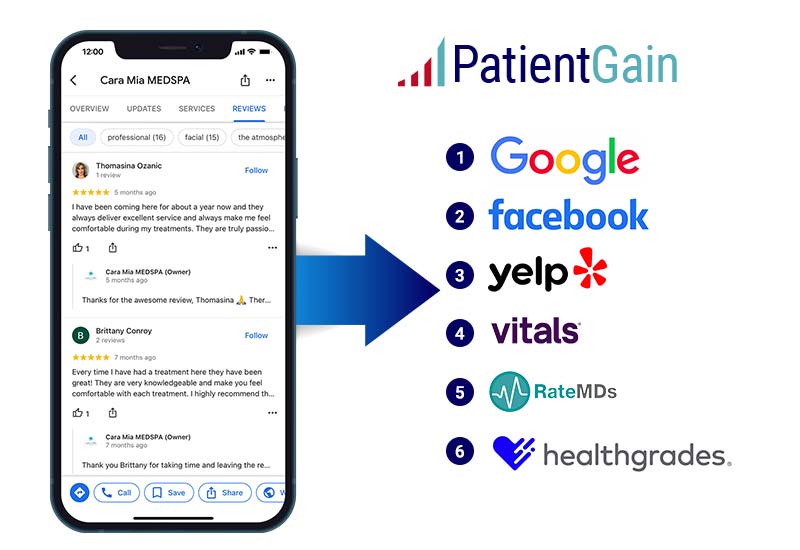
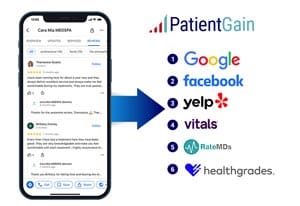
13. Facebook advertising case study
Practice: 2 location dental practice. Has been in practice for 16 years. Located in south west USA, with medium-high competition.
Objective: Get Clicks To Website (Traffic)
When You Get Charged : Link Click (CPC)
Landing Page : Targeted page for specific dental services
Call to Action : Contact Us
Age: 18-65+ Gender : All Genders
Geo Targeting: 15 mile radius
Detailed Targeting : People who match: Interests: Cosmetic dentistry, periodontitis, teeth cleaning, braces, Invisalign, implants
Monthly Budget: $1500
Total Link Clicks : 1,811
Cost Per Result: $0.82
Average Monthly Spent : $1485
Overall Campaign Results:
62 inquiries
13 conversions / new patients
14. Case study dental advertising: Google ads vs Facebook ads
Compare: month of March $2200 advertising budget on Google PPC ads. Generated 242 leads.
Compare: month of April $2200 advertising budget on Facebook ads. Generated 176 leads.
Results: Although Google ads are more complex to setup and manage, they generate more leads and patients for dental practices, given the same budget.
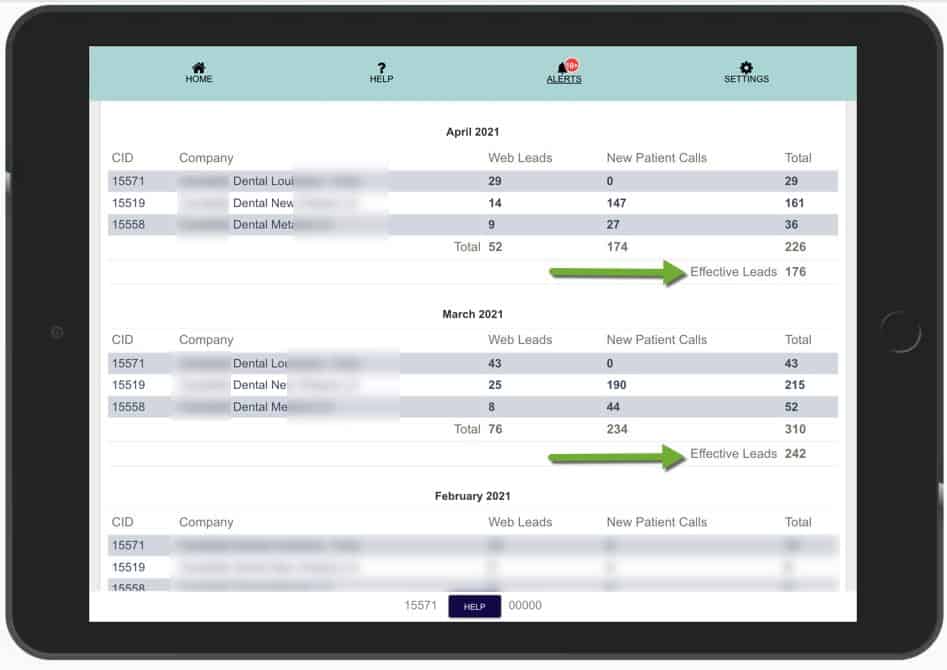
When promoting a dental practice online, two effective tools are Digital Dental Advertising and Dental SEO (Search Engine Optimization). Both strategies aim to increase visibility and attract more patients, but they function differently and cater to different needs.
Digital Dental Advertising (Pay-Per-Click or PPC)
Approach & Benefits:
- Faster Results: Platforms like Google Ads allow targeting specific demographics with ads that appear in search results quickly, often yielding results within days.
- Highly Measurable: PPC campaigns offer detailed analytics on impressions, clicks, conversions, and ROI. This allows for real-time campaign adjustments.
- Targeted Reach: Ads can be targeted very specifically based on demographics, location, interests, and online behavior, reaching potential patients who are actively searching for dental services.
- Flexibility: Campaigns, budgets, and targeting can be adjusted easily based on performance data.
- Cost: PPC involves ongoing costs—you pay each time someone clicks on your ad. Costs vary based on keywords, competition level, and budget.
Dental SEO (Search Engine Optimization)
Approach & Benefits:
- Long-Term Benefits: SEO is a strategy that builds organic traffic over time. High rankings in search results for relevant keywords can bring consistent patient acquisition without ongoing ad spend.
- Cost-Effective: While SEO requires upfront investment in keyword research, content creation, and site optimization, there is no cost per click as with PPC.
- Builds Trust and Credibility: A well-optimized website with high-quality, informative content can make your practice a trusted resource, enhancing patient trust.
- Sustainable Growth: SEO can generate a steady stream of qualified leads over time, as organic search traffic is more consistent and reliable.
- Slower Results: Improving your website’s search rankings takes time and effort, and significant results may not be evident for several months.
Integrating Both for Maximum Effectiveness
A well-rounded digital marketing strategy for a dental practice often includes both digital advertising and SEO. Ads provide quick visibility and patient influx, ideal for promoting specific offers or for new practices needing an immediate patient base. Meanwhile, SEO builds a foundational online presence that supports long-term growth and builds credibility.
By understanding and deploying both Digital Dental Advertising and Dental SEO, dental practices can effectively manage both immediate needs and long-term goals, ensuring a steady flow of new patients and sustainable practice growth. This integrated approach allows practices to leverage the immediate impact of PPC while building a durable online presence through SEO.
The experts at PatientGain.com can help your dental advertising. Call our experts today and let us show you what we have done for other dentists across the country. We look forward to working with you!
